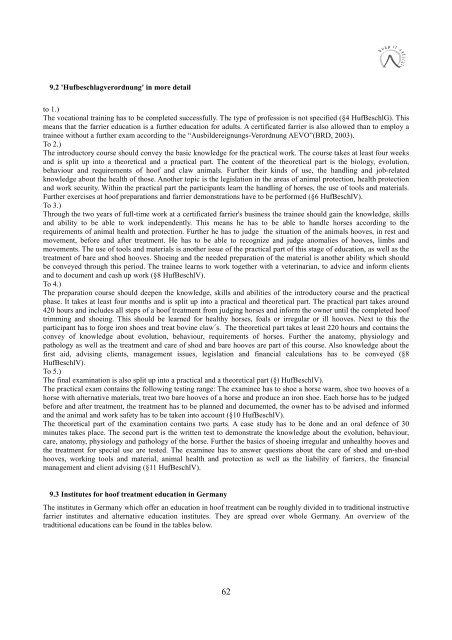Bachelor Thesis - Christina Kuenen - Hufpfleger
Bachelor Thesis - Christina Kuenen - Hufpfleger
Bachelor Thesis - Christina Kuenen - Hufpfleger
Create successful ePaper yourself
Turn your PDF publications into a flip-book with our unique Google optimized e-Paper software.
9.2 'Hufbeschlagverordnung' in more detail<br />
to 1.)<br />
The vocational training has to be completed successfully. The type of profession is not specified (§4 HufBeschlG). This<br />
means that the farrier education is a further education for adults. A certificated farrier is also allowed than to employ a<br />
trainee without a further exam according to the “Ausbildereignungs-Verordnung AEVO”(BRD, 2003).<br />
To 2.)<br />
The introductory course should convey the basic knowledge for the practical work. The course takes at least four weeks<br />
and is split up into a theoretical and a practical part. The content of the theoretical part is the biology, evolution,<br />
behaviour and requirements of hoof and claw animals. Further their kinds of use, the handling and job-related<br />
knowledge about the health of those. Another topic is the legislation in the areas of animal protection, health protection<br />
and work security. Within the practical part the participants learn the handling of horses, the use of tools and materials.<br />
Further exercises at hoof preparations and farrier demonstrations have to be performed (§6 HufBeschlV).<br />
To 3.)<br />
Through the two years of full-time work at a certificated farrier's business the trainee should gain the knowledge, skills<br />
and ability to be able to work independently. This means he has to be able to handle horses according to the<br />
requirements of animal health and protection. Further he has to judge the situation of the animals hooves, in rest and<br />
movement, before and after treatment. He has to be able to recognize and judge anomalies of hooves, limbs and<br />
movements. The use of tools and materials is another issue of the practical part of this stage of education, as well as the<br />
treatment of bare and shod hooves. Shoeing and the needed preparation of the material is another ability which should<br />
be conveyed through this period. The trainee learns to work together with a veterinarian, to advice and inform clients<br />
and to document and cash up work (§8 HufBeschlV).<br />
To 4.)<br />
The preparation course should deepen the knowledge, skills and abilities of the introductory course and the practical<br />
phase. It takes at least four months and is split up into a practical and theoretical part. The practical part takes around<br />
420 hours and includes all steps of a hoof treatment from judging horses and inform the owner until the completed hoof<br />
trimming and shoeing. This should be learned for healthy horses, foals or irregular or ill hooves. Next to this the<br />
participant has to forge iron shoes and treat bovine claw´s. The theoretical part takes at least 220 hours and contains the<br />
convey of knowledge about evolution, behaviour, requirements of horses. Further the anatomy, physiology and<br />
pathology as well as the treatment and care of shod and bare hooves are part of this course. Also knowledge about the<br />
first aid, advising clients, management issues, legislation and financial calculations has to be conveyed (§8<br />
HufBeschlV).<br />
To 5.)<br />
The final examination is also split up into a practical and a theoretical part (§) HufBeschlV).<br />
The practical exam contains the following testing range: The examinee has to shoe a horse warm, shoe two hooves of a<br />
horse with alternative materials, treat two bare hooves of a horse and produce an iron shoe. Each horse has to be judged<br />
before and after treatment, the treatment has to be planned and documented, the owner has to be advised and informed<br />
and the animal and work safety has to be taken into account (§10 HufBeschlV).<br />
The theoretical part of the examination contains two parts. A case study has to be done and an oral defence of 30<br />
minutes takes place. The second part is the written test to demonstrate the knowledge about the evolution, behaviour,<br />
care, anatomy, physiology and pathology of the horse. Further the basics of shoeing irregular and unhealthy hooves and<br />
the treatment for special use are tested. The examinee has to answer questions about the care of shod and un-shod<br />
hooves, working tools and material, animal health and protection as well as the liability of farriers, the financial<br />
management and client advising (§11 HufBeschlV).<br />
9.3 Institutes for hoof treatment education in Germany<br />
The institutes in Germany which offer an education in hoof treatment can be roughly divided in to traditional instructive<br />
farrier institutes and alternative education institutes. They are spread over whole Germany. An overview of the<br />
tradtitional educations can be found in the tables below.<br />
62


